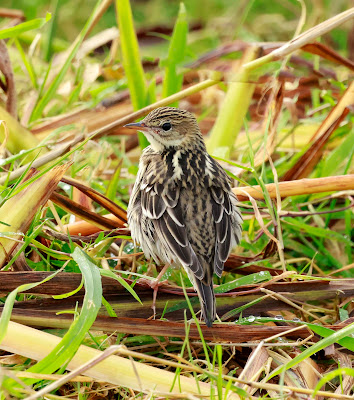Mark and myself, being based in Scalloway had been mainly concentrating on birding that part of Mainland, the largest island in Shetland, south of Lerwick and today we had an incentive to return there like no other, as a report came in the early morning of a Pechora Pipit being discovered at Quendale Mill.
Quendale Mill is a well known and very popular place to go birding as many a major rarity has been found there and it is covered daily at this time of year from dawn to dusk by various birding groups and independent birders such as us
It is a forty five minute drive from our house in Scalloway to Quendale Mill and we knew when we got there we would be in the company of many other birders keen to see this charismatic ultra rarity from the East
Pechora Pipits are one of those select species that any serious birder who comes to Shetland hopes to see.They breed in northern Siberia, northeast China and southeast Russia and spend their winter in Indonesia and The Phillipines.So this bird at Quendale had come a very long way and in the wrong direction.
They used to be a Fair Isle speciality, a bird of myth and legend that you had to make an extreme journey to go and see on that fabled island, lying between Shetland and Orkney.In latter years it has been encountered in other parts of Shetland too. To date 122 have been recorded in Britain and 95 of those are from Shetland which constitutes a remarkable 82% of all records. Very much a bird of the North.
The last one recorded in Shetland, which I went to see, was at Hillswick on Mainland in October 2022 which was frequenting an extensive iris bed and prompted a large twitch resulting in only flight views of the bird and brief views of it perched on a wall.It was not a particularly edifying spectacle with the bird never visible on the ground and consequently being continually flushed.
Would it be the same at Quendale? Probably not as the topography was not so conducive to the bird being flushed.
We arrived at Quendale Mill to find a reasonable crowd but not as many as I had feared and nowhere near the scrum that had been at Hillswick.Everyone was well behaved and stood on the track that runs away from the Mill towards a disused quarry.
As we headed up the track we could see birders looking at presumably the pipit in the irises by the burn but almost immediately the pipit flew up and over the track to disappear into the irises on the other side by the wall.
Well that was quick.At least we have seen it. I remarked
Obviously we wanted to achieve much better than this but at least some of the inevitable anxiety and pressure that comes with chasing rarities was assuaged.
Mark however was determined to get a decent photograph
We joined the crowd and waited to see what would happen but.the pipit remained hidden for quite some time before flying up out of the irises onto the wall and perched there for a couple of minutes giving spectacular views.
Having revealed itself to one and all ithe pipit flew down into the irises and was gone from view.
Both of us then stood around until it showed itself again on the wall and was, as before, just as obliging and this behaviour formed a pattern throughout the day.The pipit disappearing for some time then re-appearing for a brief spell on the wall as if to check all was well.
We were both pleased with our photos and as the bird was so showy many were satisfied with the views they had got and departed and as the number of birders decreased the pipit became more showy still.
We spent almost the entire day here watching and photographing it.Mark being the keen and very good photographer he is likes to get the ultimate image so we were not going anywhere but that was fine with me.
For some variety I went to a small copse by the start of the track and found a Yellow browed Warbler. Quendale Mill is now a visitor attraction and is situated amongst a working dairy farm, the buildings stark and the roads permanently wet and muddy.I wandered around the back of the barns and found a couple of Barred Warblers in a stand of nettles with a huge flock of House Sparrows and Starlings
.jpg) |
| Quendale Farm |
We went home but Mark never satisfied wanted to go back the next day assuming the pipit was still there.Who was I to argue.
The report of the pipit's continued presence duly arrived in the morning and we set off for Quendale
When we got there we discovered the pipit had transferred to the other side of the track where the burn ran alongside and iris beds proliferated. As with yesterday it was almost immediately on view and continued to be so for most of the day, threading and weaving its way, with pink legs and long pink toes over and under irises and grass, much like a combination of a Lanceolated Warbler and an Olive backed Pipit. I mainly watched it today rather than take a huge number of photos and saw it bathing at least three times in the burn and pulling small worms from the mud as well as catching other invertebrates.It was constantly active and feeding apart from the bathing sessions and when on several occasions it came particularly close I indulged myself with my camera.Well who wouldn't?
By the end of the day we were down to only four of us diehards but two days with a showy Pechora is what it is all about.I doubt I will ever get to see a Pechora Pipit so well again.
to be continued


.jpg)









.jpg)











No comments:
Post a Comment